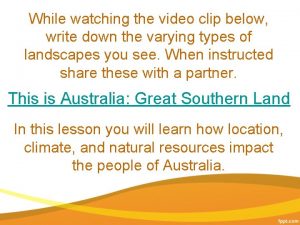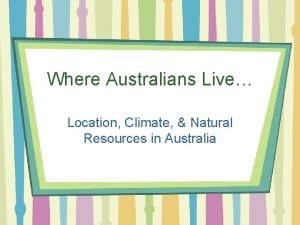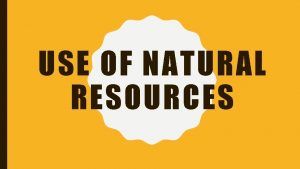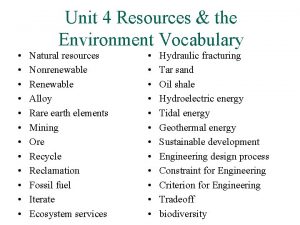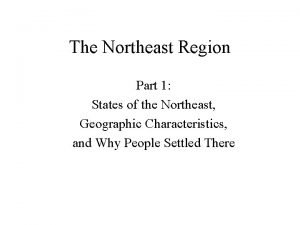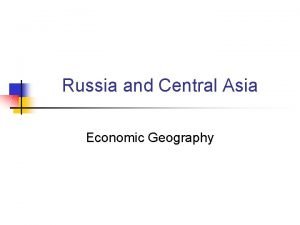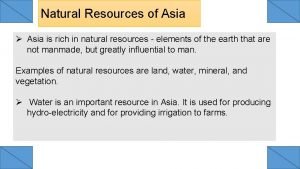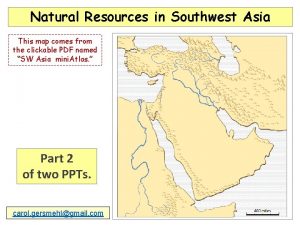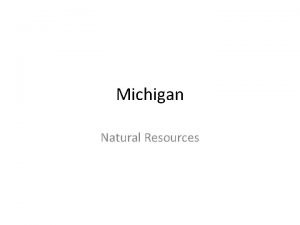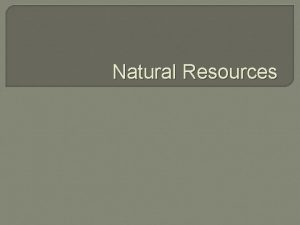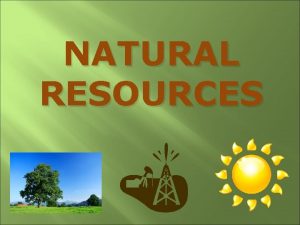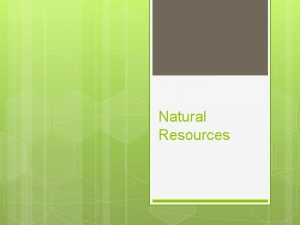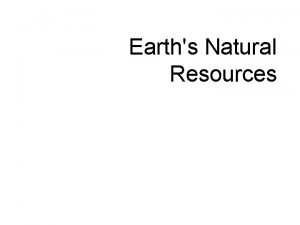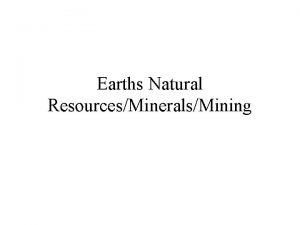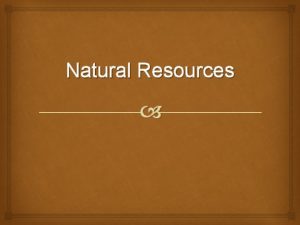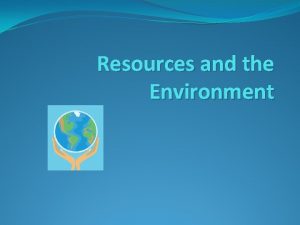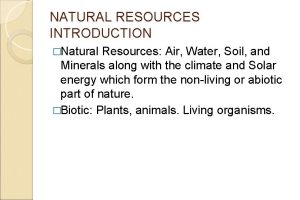NATURAL RESOURCES MANAGEMENT NATURAL RESOURCES MANAGEMENT 1 INTRODUCTION











- Slides: 11

NATURAL RESOURCES MANAGEMENT

NATURAL RESOURCES MANAGEMENT 1. INTRODUCTION NR & NRM 2. ECOLOGICAL PRINCIPLES FOR NRM 3. ECOSYSTEM SERVICES 4. CLIMATE CHANGE & NRM

1) Natural resources : Natural resources are the resources available in a nature like air, water, sunlight, soil, minerals, forests, wild life etc. Natural resources are of two main types. They are renewable and non renewable natural resources. i) Renewable natural resources : Are the resources which can be replenished in a short period of time like air, water, sunlight, forests etc. ii) Non renewable natural resources : Are the resources which cannot be replenished in a short period of time like minerals (coal, petroleum, natural gas, metals etc. ) because they take millions of years to be formed. Human activities produce a lot of waste materials which are thrown away into the environment. These wastes cause pollution of natural resources like air, water and soil.

2) The Three R’s to save the environment : The three R’s to save the environment are Reduce, Recycle and Reuse. i) Reduce : - means using less of natural resources and avoiding wastage of natural resources. ii) Recycle : - means the materials like paper, plastic, glass, metals etc. used for making things can again be used for making new things instead of synthesising or extracting new paper, plastic, glass or metals. iii) Reuse : - means using things again and again like the plastic bottles in which we buy jams, pickles etc can be again used for storing things in the kitchen.

3) Need for management of natural resources : All the things we use and consume are obtained from natural resources. Due to increase in population, industrialisation and urbanisation the demand for natural resources is increasing and their availability is limited. So there is a need for proper management of natural resources. The proper management of natural resources consists of : i) Judicious use of natural resources and avoiding wastage of natural resources. ii) Long term planning for the use of natural resources so that it last not only for the present but also for future generations. iii) The exploitation of natural resources should not be for the benefit of a few people but should be distributed equally for all. iv) While extracting and using natural resources we should also plan for the safe disposal of wastes so that no damage is caused to the environment.

4) Forests : a) Importance of forests : i) Forests help to preserve biodiversity. ii) Forests are natural habitats of plants and animals. iii) Forests provide timber, wood, fuel, medicines, fodder, etc. iv) Forests help to maintain ecological balance. v) Forests help to control climate and rainfall. vi) Forests help to prevent soil erosion and controls floods. vii) Forests help to maintain the oxygen – carbon dioxide balance in nature. b) Stake holders of forests : People who are associated with forests directly or indirectly are : i) People living in and around forests depend on forests for their livelihood. ii) Industrialists who use the raw materials from forests for manufacturing paper, medicines, furniture etc. iii) Forest Department of the Government who owns the forests and controls the resources from the forests. iv) Nature and wild life organisations who want to conserve and preserve forests.

c) Conservation of forests : Forests can be conserved by : i) Afforestation – planting of more trees. ii) Preventing or reducing deforestation. iii) Preventing over grazing by cattle. iv) By setting up wildlife sanctuaries, national parks, biosphere reserves etc. v) Undertaking social forestry programs like Van Mahotsav, Chipko movement for planting and protecting trees on a large scale.

5) Wildlife : - a) Importance of wildlife : i) Wildlife helps to preserve biodiversity. ii) Wild life helps to maintain food chains and food web. iii) We get useful products from wild life like food, medicines, leather, bones, honey, lac etc. b) Conservation of wildlife : i) Preserving the natural habitats of animals. ii) Banning poaching of animals. iii) Protecting endangered species of animals. iv) Setting up of wildlife sanctuaries, national parks, biosphere reserves etc.

6) Water : - a) Uses of water : Water is a basic necessity for all living things. We use water for our daily needs, for agriculture, transportation, construction of buildings, roads, dams etc. Water is a natural habitat for aquatic organisms. Human activities are affecting the availability of water and causing pollution of water bodies. b) Dams : Advantages of dams : i) Irrigation of crops. ii) Producing electricity. iii) Supplying water to towns and cities. iv) To control floods. Disadvantages of dams : i) Social problems : - It displaces a large number of people who have to be rehabilitated. ii) Economic problems : - It is expensive and uses a huge amount of public money. iii) Environmental problems : - It causes deforestation and loss of biodiversity.

c) Water harvesting (Rain water harvesting) : Water harvesting is collecting and storing rain water for future use. The common methods of water harvesting are : i) Digging pits, ponds, lakes etc. ii) Building small earthen dams or concrete check dams. iii) Construction of dykes. iv) Construction of reservoirs. v) Construction of rooftop collecting units in houses. d) Advantages of underground water : i) It does not evaporate easily. ii) It spreads out and recharges wells. iii) It provides moisture for irrigation of crops. iv) It does not get polluted easily. v) It does not provide breeding ground for mosquitoes and houseflies.

7) Coal and petroleum: Coal and petroleum are fossil fuels formed by the decomposition of dead plants and animals inside the earth after several millions of years. They are non renewable sources of energy. Petroleum reserves may last for about 40 years and coal reserves may last for about 200 years. Coal and petroleum contain carbon, hydrogen, nitrogen and sulphur. When they are burnt, they release carbon dioxide and oxides of nitrogen and sulphur. Carbon dioxide is a green house gas which causes global warming. Oxides of nitrogen and sulphur combines with moisture in the air and produces acid rain.
 Transformation process
Transformation process Variable resources examples
Variable resources examples Renewable resources vs nonrenewable resources
Renewable resources vs nonrenewable resources Australia major natural resources
Australia major natural resources Central australia natural resources
Central australia natural resources What are types of natural resources
What are types of natural resources Natural resources vocabulary
Natural resources vocabulary Northeast physical characteristics
Northeast physical characteristics Warsaw pact countries
Warsaw pact countries Is asia rich in natural resources
Is asia rich in natural resources Natural resources of southwest asia
Natural resources of southwest asia Natural resources found in michigan
Natural resources found in michigan



